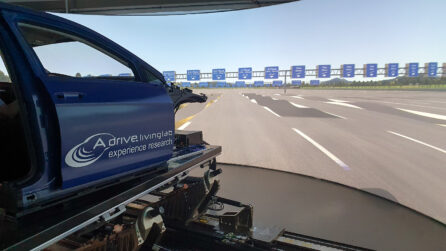Integration of a vehicle body on the aVDS driving simulator

Since March this year, our colleagues of the Adrive Living Lab of the University of Applied Sciences Kempten have been using a new advanced vehicle driving simulator (aVDS) from AB Dynamics and Williams Advanced Engineering for their research activities. By integrating a vehicle cockpit, the Kempten-based research institute has now taken another important step towards improving the experience of virtual driving tests on the driving simulator.
At the rollout event in March this year, Science Minister Bernd Sibler as well as local hero and Formula E professional driver Daniel Abt were the first test drivers to have the opportunity to test the novel driving simulator in front of guests from politics, business and science. One of the biggest challenges for the success of virtual driving tests on dynamic driving simulators is to create the most complete immersion possible in the simulation environment. A realistic depiction of the driver’s environment on the simulator enables drivers to perceive the essential factors in vehicle behavior. This includes in a decisive way the driver’s workplace. With the integration of the body of a Golf VII on the aVDS, our partner has taken a big step towards the goal of bridging the gap between virtual and real driving tests.
In the context of automated driving, the main areas of application of the driving simulator lie in the ability to experience and evaluate new driving functions and operating concepts. Due to the high dynamics of the novel simulator concept, there are also applications in vehicle dynamics, for example in the property evaluation of steering systems, chassis set-ups or tires.
For these applications in particular, it is of crucial importance that the driver’s trained perception of vehicle dynamic performance is not restricted by an unfamiliar workplace. But even for experiments such as subject-studies with amateur drivers, an environment familiar from road vehicles offers considerable advantages over the usually prototypical appearance of most driving simulators when performing demanding driving or evaluation tasks.
Serial body instead of prototype construction
A special feature of the new aVDS cockpit is that it is not a complex prototype construction especially for simulator use. Instead, the Kempten research team decided to rebuild a production vehicle so that it can be connected to the CFK motion platform. This has the decisive advantage that mostly series components were used, for example, the entire control units of the vehicle interior could be taken over. This greatly reduces the costs of an individual customer’s bodywork. In addition, it drives on the driving simulator like a normal VW Golf. Despite all these advantages, the total weight of the vehicle body could be reduced to less than 380kg by using accessories made of GRP for doors and side panels. Thanks to the modular connection, the research team can also switch between different cockpits in the shortest possible time, so that project partners can work in their own familiar vehicle environment in the future, if desired.
Hardware-in-the-Loop on the driving simulator
Beyond the pure perception of the vehicle interior, the new cockpit concept at the Kempten simulator offers the possibility of using hardware from series production vehicles for virtual driving tests. The entire steering system of the road vehicle, from the steering wheel to the gear rack, is located in the body. By using the additional steering module with rack and pinion actuator from MdynamiX this interface can be moved even further. If desired, this allows the integration of complete steering systems including the control units for steering assistance, the aVDS thus becomes a dynamic hardware-in-the-loop test bench.


